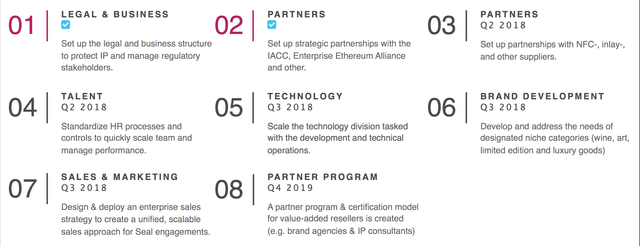Seal – Blockchain based Seal of Approval

This is maybe the most obvious application of the blockchain tech among all obvious applications. The Seal project develops a platform that would allow attaching special tags to all manufactured objects. Those tags would refer to entries on the blockchain, so naturally, there'll be no way to falsify them. The project's goal is to protect markets from counterfeit products proudly carrying on them the names of popular brands.
There are many problematic aspects related to the production and distribution of high-quality goods. The obvious one is counterfeit products, inundating primary and secondary markets. In many cases, it's really hard to distinguish at first glance between a genuine and fake thing. Apart from the fact that such situation hurts authentic brand producers, counterfeit products, manufactured without regard to original technologies and materials, might pose serious safety and health hazards. Apparently, their quality is much lower as well.
This situation, in turn, leads to the loss of trust in consumers. When people are aware that the market is flooded with low-quality fake imitations they might lose interest in buying certain brands altogether. An average consumer usually cannot distinguish between genuine and fake product, and it makes one always wonder if he or she owns a real thing or a cheap imitation. As a result, the popularity and reputation of brands plunge, which quickly translates into diminishing demand and profits.
Another less obvious problem is so-called "night shifts". It means a situation when the facilities, producing certain brands, also produce an additional volume of product, selling it through alternative channels of distribution. That additional produce, though authentic and of the same quality as the original product, is unlicensed; it doesn't pass through the standard companies' control and distribution mechanisms, and this can harm brands' overall profits since revenues from "night shifts" never reach companies' coffers.
The third potentially negative fact is related to brand affiliates and distribution channels, namely, the situation when products are distributed on the second-tier markets for a price lower than nominal product price. It's technically not an illegal practice, but it nevertheless affects brand's standing and pricing strategies. Prices in various countries are defined by the country's overall economic level, tax and customs policies, and local currency rates relative to the global market. Naturally, companies price their product differently for different countries, but to avoid disbalance and speculations, they usually create specific product lines and models for specific markets. Nevertheless, it's very hard to track what's sold where; that, for example, items from a product line designated for a certain country are not distributed elsewhere, driving speculation.

The Seal startup came up with an idea to register all and each of ever produced items on the blockchain. It works like that: Each piece of merchandise has a special tag attached to it. This tag, or in project's terminology Seal, has in it a special code that's registered on the blockchain. Through the verification of this code, it's possible to track both product's origins and its current status. For example, it allows revealing stolen items or items from a defective batch, marked for a product recall. Since technically an identifying seal with all its contents can be duplicated and attached to a counterfeit product, each identification procedure alters the seal contents and creates a new corresponding blockchain record with updated code. The new record invalidates the previous one. Thus any attempt to perform an identification of a fake item with a copied seal will fail since it will send to the identification provider a piece of information, invalidated in the process of the previous check.
The project has its key mechanisms of product identification and tracking already implemented, and gears up to establish a worldwide network, aiming to fight counterfeit production and distribution malpractices. In fact, the potential of such system, if put in practice, is quite impressive. For example, it can effectively eliminate theft. Thieves just won't be able to sell stolen items since identification seals will serve in this case as beacons, indicating the item's current status, namely, that it has been stolen. At the same time, the product identification network can help organizing simple and logistically painless product recalls. For example, an owner of a defective model will get a notification that his purchase is a subject to product recall, and he can get a refund or have the faulty item replaced with a better one. On a grander scale, the system allows to control channels of distribution and track the products' lifecycle, particularly their re-emergence on secondary markets.
Apart from combating counterfeit the system of products' blockchain tracking is valuable for companies' marketing and logistics. For example, it allows revealing the areas where certain brands and models are particularly popular, as well as identifying the most effective channels of distribution.
Technplogy roadmap

Corporate roadmap

Currently, Seal conducts a token sale with an aim to distribute 492,000,000 Seal Tokens

This is my @originalworks
Resteemed by @resteembot! Good Luck!
Curious? Read @resteembot's introduction post
Check out the great posts I already resteemed.
ResteemBot's Maker is Looking for Work
This post has received a 0.15 % upvote from @drotto thanks to: @cryptotaofficial.
What is the coin abbreviation for seal token ?
SEAL
Thank you